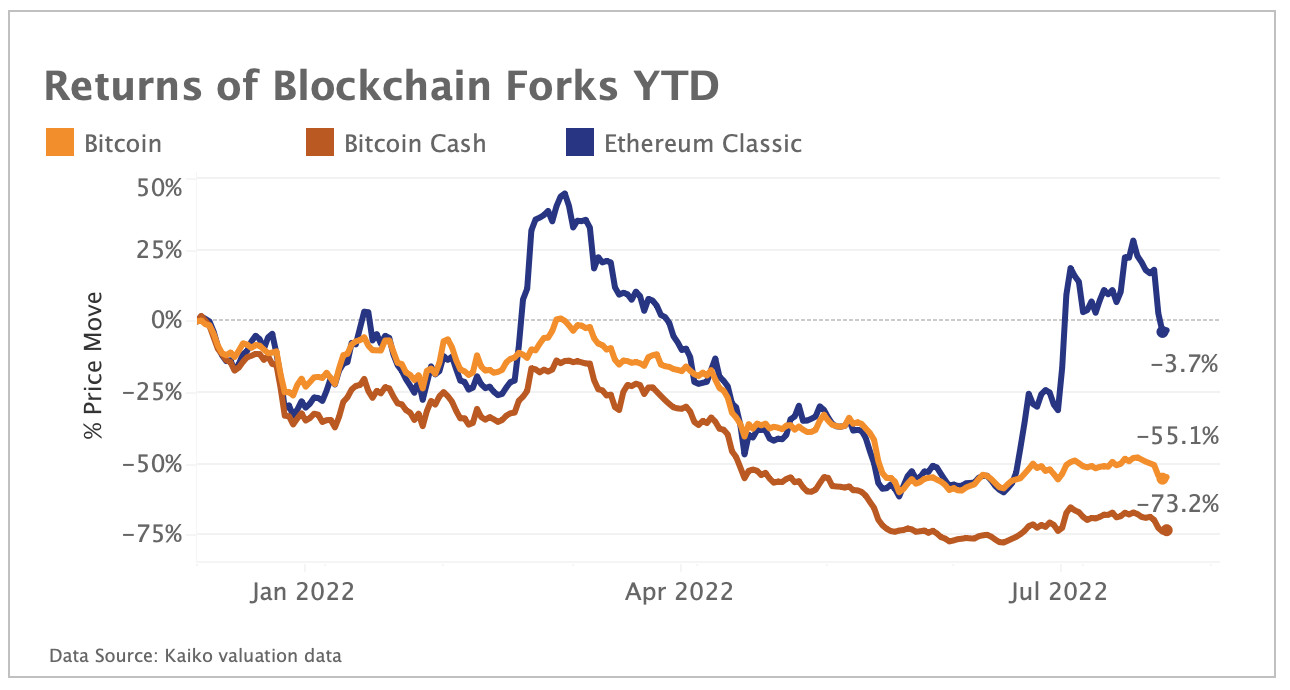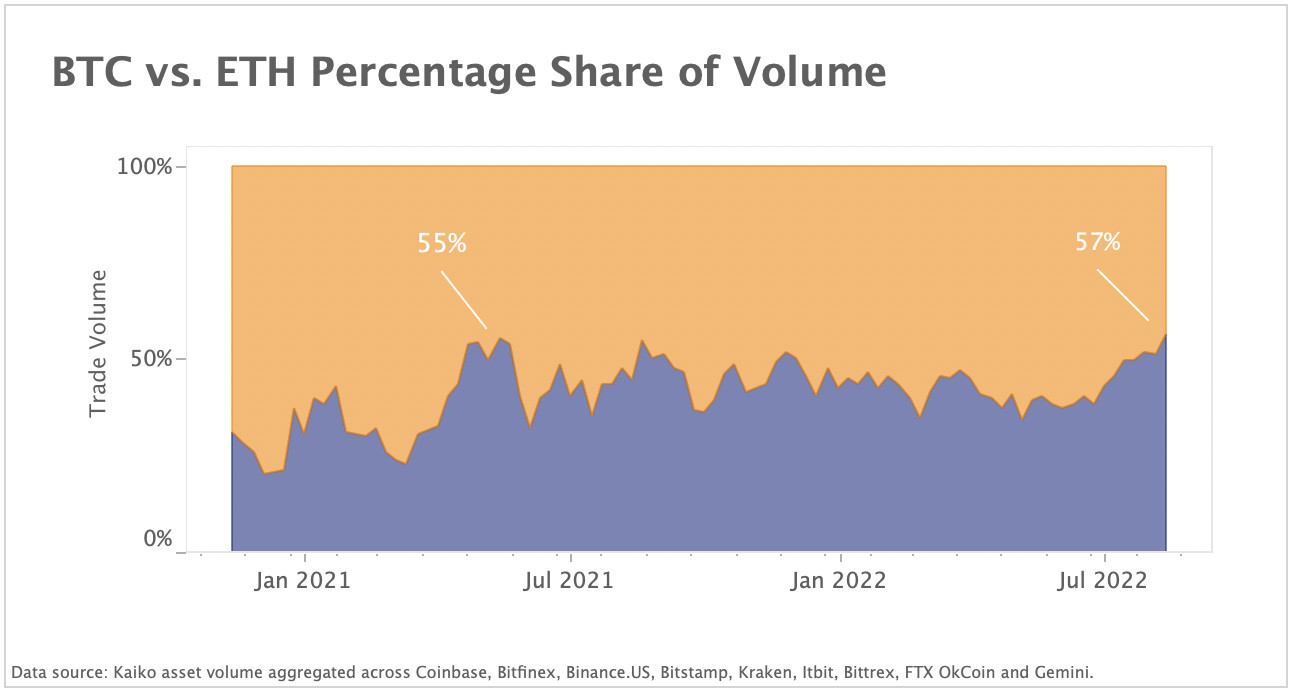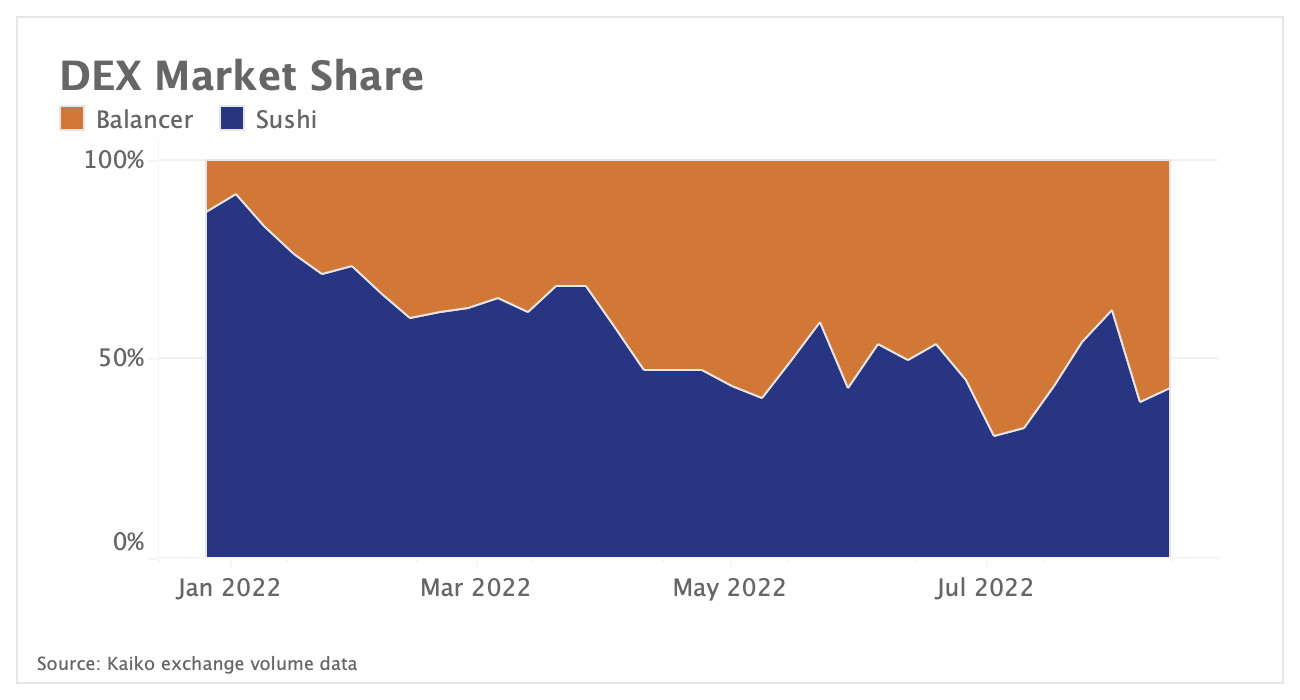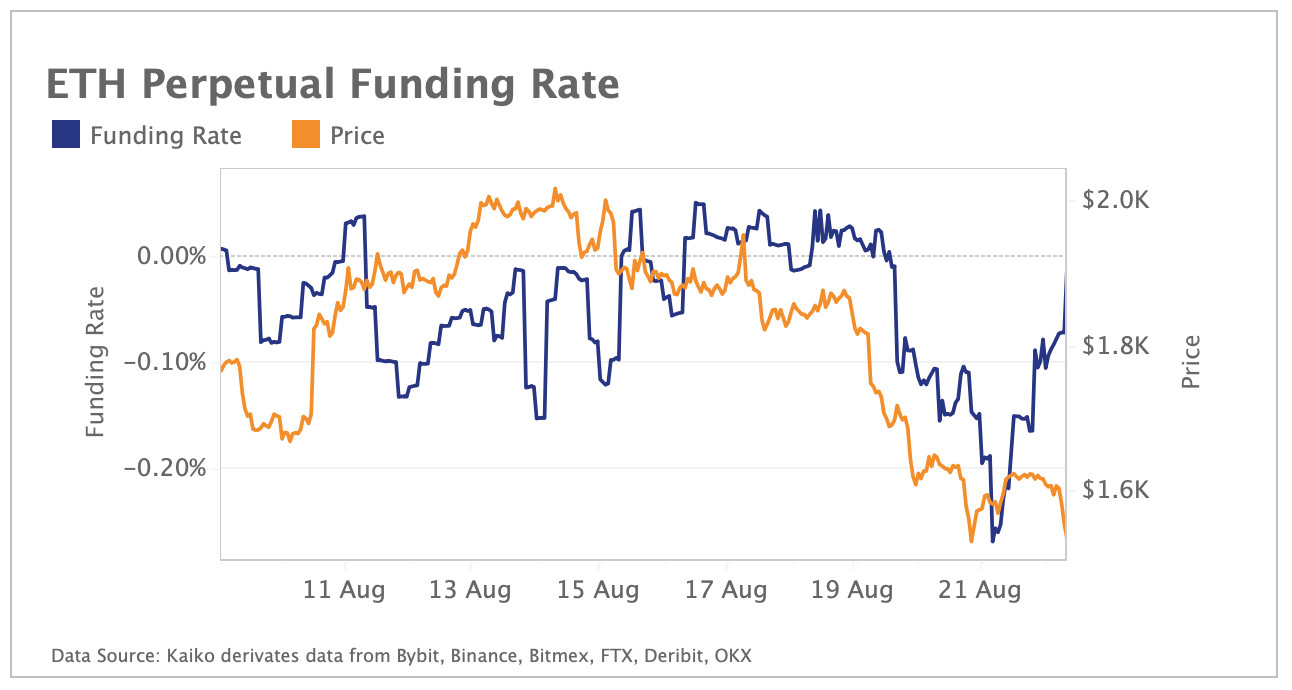A summarizing review of what has been happening at the crypto markets of the past week. A look at trending sectors, liquidity, volatility, spreads and more. The weekly report in cooperation with market data provider Kaiko.
The last 7 days in cryptocurrency markets:
- Price Movements: Ethereum Classic is outperforming Ether year to date while EOS surges following news of a hard fork.
- Market Liquidity: ETH share of volume hits highest level since 2018 and Balancer overtakes Sushiswap in volume.
- Derivatives: ETH open interest falls to lowest level this month but long positions are building at lower price levels.
- Macro Trends: UK Inflation comes in hot and expected to rise, painting gloomy picture for Europe.
Sentiment turns sour as liquidations mount

Bitcoin (BTC) and Ethereum (ETH) are down double-digits in percentage terms last week, falling in sync with global equities following hawkish minutes from the Fed’s July meeting. The selloff spurred cascading long liquidations across derivatives markets which helped send crypto markets further south. In other industry news, the US Federal Deposit Insurance Corporation (FDIC) warned five companies, including FTX US, to stop misleading claims about deposit insurance, while South Korea is mulling taxing airdrop recipients. The challenging market conditions continue to put a strain on stablecoins as Tether’s USDT saw its reserves tumble by $16bn in Q2 due to redemptions as traders flocked into cash, while Acala's stablecoin aUSD on Polkadot lost its peg due to a liquidity pool bug.
Ethereum Classic gives up gains but still outperforms
With talk of another fork of Ethereum in the form of ETHPOW ahead of the Merge, investors have turned to another old fork of the Ethereum network, Ethereum Classic. Ethereum Classic is a hard fork of Ethereum built from those who did not support the relaunch of Ethereum back in 2016. The hard fork maintained the original blockchain and renamed it to Ethereum Classic, a story bearing a lot of resemblances to the ETHPOW narrative at the moment. Ethereum Classic has outperformed not only other forks, such as Bitcoin Cash, but also BTC and ETH year to date. Investors in Ethereum Classic seem to be either betting on a failed Merge, a delayed Merge, or an improved network with the arrival of more miners. Ethereum miners that will be left without a purpose on the new Proof-of-Stake (PoS) Ethereum blockchain, and will presumably either flock to Ethereum Classic, which will remain Proof-of-Work, or to the newer fork, ETHPOW. In the past week however, Ethereum Classic has retraced its gains and fallen over 20% as a delayed Merge seems less and less likely by the day.
EOS surges after news of hard fork
On August 18 a NY judge did not grant approval on a June 2021 settlement between Block.one and investors, in part because he believed the lead plaintiff in the class action could not properly represent U.S. investors. In the days leading up to the ruling, developers had been hinting on Twitter that EOSIO would be rebranded by the EOS Network Foundation (which itself is seeking $4.1bn in damages from Block.one). It was later announced that EOSIO will be hard forked to Antelope, which will use a delegated proof-of-stake consensus mechanism. The EOS token surged on the news of the hard fork before returning to previous levels. However, it has since surged again and is up over 40% in the last 30 days, while ETH is roughly flat.
ETH volume share hits highest level since 2018
Ethereum’s market share of weekly trade volume hit its highest level since 2018, exceeding its previous peak of 55% during the May 2021 selloff. The volume market share of ETH-USD relative to BTC-USD aggregated on ten exchanges has surged from 38% mid-July 2022 to 57% last week. The main driver of ETH trading activity in July has been increased optimism around the Merge and an improvement of global risk sentiment. However, last week’s selloff across markets confirms that ETH remains a higher beta play. As risk sentiment soured, BTC price decreased by 12% while ETH lost 17% of its value. Overall, the average weekly trade volume is down significantly relative to last year’s average.
Looking at market depth aggregated across the same exchanges, Ethereum’s market depth has been on a downward trend since early August, falling by 23% to around 45K ETH. On Friday alone the 2% ETH-USD market depth plummeted by 10% while Bitcoin’s market depth also decreased as market makers adjusted their positions amid a wider market sell-off. Bitcoin's market depth still remains higher than the start of August, which suggests market makers are providing liquidity asymmetrically for the two assets and sentiment around Ethereum is fragile ahead of the Merge.
Balancer passes Sushi in DEX market share
Balancer has gained significant ground on Sushi since the beginning of the year, increasing from 10% of market share in the first couple weeks of the year to roughly 60% now. This has been partially driven by the recent success of the Balancer Boosted Aave USD pool, which began to facilitate increased volumes in May and has remained one of the most active Balancer pools. Boosted Pools are a unique Balancer innovation that are designed to provide deep liquidity while sending idle tokens to protocols like Aave. This makes providing liquidity more appealing, as LPs receive yield from Aave and swap fees from the pool. While this innovation appears to have been successful for Balancer, both Sushi and Balancer are relatively small players in the DEX landscape.
ETH open interest falls with price but spikes Monday morning
Open Interest denominated in ETH reached its lowest levels this month as ETH’s price crashed below $1,600 and open positions in the futures market were liquidated. However, as the price dipped below $1,600, we observed a significant spike in open interest this morning as new money came flooding into the futures market for ETH. Looking at funding rates we can determine the directionality of these new positions over the last day, whether they were mostly long or short.
Funding rates for ETH have been mostly mixed in the month of August with positive funding rates recorded as ETH hovered around $2,000. As ETH crashed to the $1,600 mark last week, funding rates dipped sharply negative to monthly lows. In the last day or two, however, funding rates improved off the lows and spiked rather significantly, approaching neutral this morning. When combined with the spike in open interest we observed this morning, it seems these new positions in ETH futures are biased long and investors are bullish at these price levels.
UK Inflation above estimates and expected to rise further
Inflation in the UK hit its highest level in 40 years last week, rising to 10.1% in July. The double digit inflation reading was above a consensus estimate of 9.8% and has risen from 9.4% in June. Unlike other developed economies such as the US, whose inflation seems to have peaked, estimates are for inflation in the UK to increase further by year end, as high as 18.6% according to a new forecast from Citigroup. These levels increase the pressure on the Bank of England to aggressively raise interest rates, and likely point towards a recession in the UK. High inflation figures in the UK paint a worrying picture for Europe and could indicate that inflation hasn’t peaked there either. This is largely due to energy prices increasing across Europe as Russia withholds supplies of natural gas, with the continent facing a potential economic crunch this winter.












